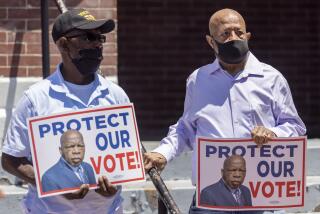‘Free and Fair’ Are the Missing Bosnia Elements
- Share via
SARAJEVO, Bosnia-Herzegovina — Bosnian elections have been steadily downgraded by the master of the ceremony, Ambassador Robert Frowick of the Organization for Security and Cooperation in Europe, from “free and fair” to “reasonably democratic” to “not the sort of democratic, free and fair elections that we have known in the democracies of the world.” On Saturday, we will hit the bottom.
What is planned cannot even be called “elections.” Apartheid-like segregation will be enforced by different international security forces to minimize the risk of any interethnic contact. Barbed wire, not bouquets of flowers, will welcome voters who briefly return to places from which they were ethnically cleansed. So much for reconciliation, freedom of movement and politically neutral environment, those cornerstones of the Dayton peace agreement.
There are genuine concerns that violence will mar E-day in Bosnia. The security plan for the elections, prepared by OSCE and other international organizations and with ministers of interior representing all parts of Bosnia--deals with the possible movement of tens of thousands of displaced persons who may be traveling to vote in places where they lived in 1991.
The OSCE’s reports warned that “the human rights community is very concerned that security planning not restrict the right to vote.” The warning is no exaggeration. In its eagerness to reduce the risks of some mishap, the signatories to the plan simply reduced the number of voters, thus condoning a large-scale disenfranchisement of displaced persons, mostly Bosniaks (or Muslims as the press calls them) evicted from the territory now under Bosnian Serb control.
As it stands now--and it is too late in the game to change anything short of canceling the elections altogether--the plan is a fraud.
There will be 19 “voter routes” between the Muslim-Croat federation and Republika Srpska with a heavy presence of security forces; only vehicles carrying at least eight people will be allowed. Cars, bicycles and pedestrians will be banned. Theoretically, vehicles carrying fewer than eight can take any other road, but that information will not be publicized lest it encourage such expeditions. Apart from what this plan says about the international community’s willingness to enforce freedom of movement, it also sells down the river the most helpless. “We are concerned that under the security plan, the most vulnerable voters will travel on the least secure roads,” says Kris Janowski, the spokesman of the U.N. refugees’ agency.
The idea is that buses provided by the authorities of all sides will carry “ethnically vulnerable” voters to a few designated polling stations across the interentity boundary. In the stations where Bosniak-displaced persons will vote, there will be no Bosnian Serbs, and vice versa. A busload of voters takes a lot of time to cast ballots, so these voters will be discouraged by NATO soldiers from dispersing while they wait. Does this sound like a stockade? It is one, in effect.
Doboj, in Republika Srpska, is a potential hot spot. The secure “voter route” to Doboj on the stretch near the boundary is a 400-meter-long, three-meter-wide corridor between two rows of concertina wire spirals more than a meter high. This tunnel, like a pen for sheep, leads to a factory situated inside Republika Srpska, where the Bosniak voters will be brought (herded?) to vote.
This model apparently will be used to accommodate all displaced persons who are voting. In other words, it will be a vote-and-run venture on routes designated by the NATO-led peace force known as IFOR to “Bosniak-dedicated” (read: ethnically clean) polling stations.
Never having really enforced freedom of movement, the international security forces (military and police) now face what they call “major traffic management problems” but which really is cumulative lack of cojnes, as they say at the United Nations. The authors of the security plan apparently count on late and contradictory information about transport of displaced persons discouraging many prospective voters from traveling to cast their ballots. Thus the number of voters will be reduced and with it, the possibility of incidents.
John Reid, OSCE’s special advisor for elections, gave his organization’s predictions for the turnout of displaced persons on E-day: “Our optimistic estimate is 28,000 to 30,000; our pessimistic estimate is 110,000.” Yes, the higher turnout figure was a “pessimistic” assessment. It seems that OSCE’s attitude toward the participation of displaced persons in these elections could be best summarized by paraphrasing a safe-sex slogan: “The safest vote is no vote at all.”
More to Read
Sign up for Essential California
The most important California stories and recommendations in your inbox every morning.
You may occasionally receive promotional content from the Los Angeles Times.













